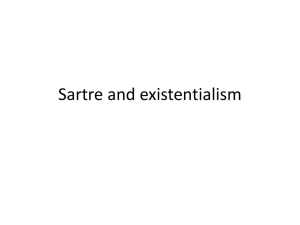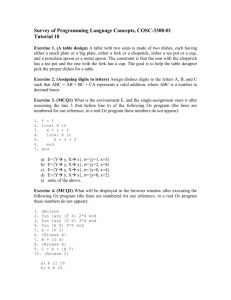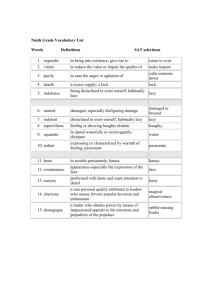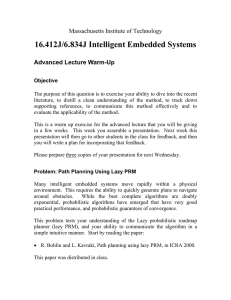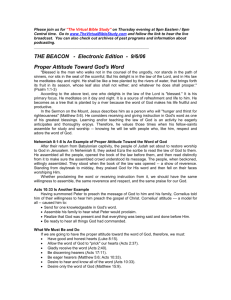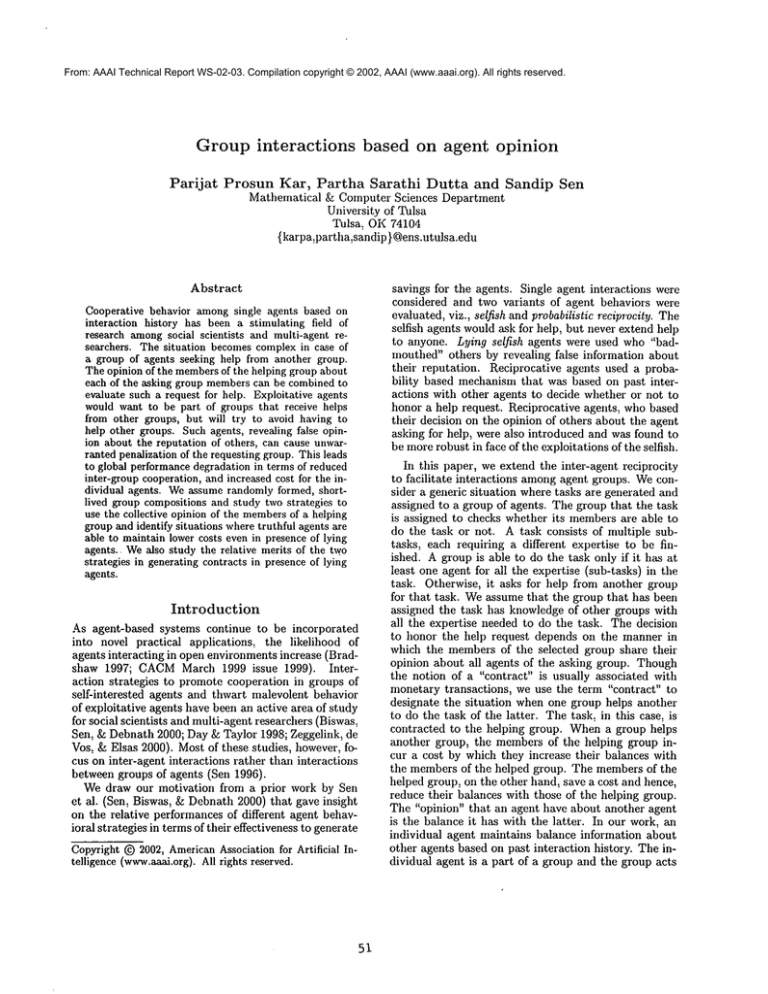
From: AAAI Technical Report WS-02-03. Compilation copyright © 2002, AAAI (www.aaai.org). All rights reserved.
Group interactions
Parijat
based
Prosun Kar, Partha Sarathi
on agent
opinion
Dutta and Sandip Sen
Mathematical
& Computer Sciences Department
University of Tulsa
Tulsa, OK 74104
{karpa,partha,sandip}@ens.utulsa.edu
Abstract
Cooperative behavior among single agents based on
interaction history has been a stimulating field of
research amongsocial scientists and multi-agent researchers. The situation becomes complex in case of
a group of agents seeking help from another group.
The opinion of the membersof the helping group about
each of the asking group memberscan be combined to
evaluate such a request for help. Exploitative agents
would want to be part of groups that receive helps
from other groups, but will try to avoid having to
help other groups. Such agents, revealing false opinion about the reputation of others, can cause unwarranted penalization of the requesting group. This leads
to global performance degradation in terms of reduced
inter-group cooperation, and increased cost for the individual agents. Weassume randomly formed, shortlived group compositions and study two strategies to
use the collective opinion of the membersof a helping
group and identify situations wheretruthful agents are
able to maintain lower costs even in presence of lying
agents. Wealso study the relative merits of the tw.o
strategies in generating contracts in presence of lying
agents.
Introduction
As agent-based systems continue to be incorporated
into novel practical applications:
the likelihood of
agents interacting in open environments increase (Bradshaw 1997; CACMMarch 1999 issue 1999). Interaction strategies to promote cooperation in groups of
self-interested
agents and thwart malevolent behavior
of exploitative agents have been an active area of study
for social scientists and multi-agent researchers (Biswas,
Sen, & Debnath 2000; Day & Taylor 1998; Zeggelink, de
Vos, & Elsas 2000). Most of these studies, however, focus on inter-agent interactions rather than interactions
between groups of agents (Sen 1996).
We draw our motivation from a prior work by Sen
et al. (Sen, Biswas, 83 Debnath 2000) that gave insight
on the relative performances of different agent behavioral strategies in terms of their effectiveness to generate
Copyright ~) 2002, AmericanAssociation for Artificial
telligence (www.aaai.org). All rights reserved.
In-
savings for the agents. Single agent interactions were
considered and two variants of agent behaviors were
evaluated, viz., selfish and probabilistic recipTvcity. The
selfish agents would ask for help, but never extend help
to anyone. Lying selfish agents were used who "badmouthed" others by revealing false information about
their reputation. Reciprocative agents used a probability based mechanism that was based on past interactions with other agents to decide whether or not to
honor a help request. Reciprocative agents., who based
their decision on the opinion of others about the agent
asking for help, were also introduced and was found to
be more robust in face of the exploitations of the selfish.
In this paper, we extend the inter-agent reciprocity
to facilitate
interactions among agent groups. We consider a generic situation where tasks are generated and
assigned to a group of agents. The group that the task
is assigned to checks whether its members are able to
do the task or not. A task consists of multiple subtasks, each requiring a different expertise to be finished. A group is able to do the task only if it has at
least one agent for all the expertise (sub-tasks) in the
task. Otherwise, it asks for help from another group
for that task. We assume that the group that has been
assigned the task has knowledge of other groups with
all the expertise needed to do the task. The decision
to honor the help request depends on the manner in
which the members of the selected group share their
opinion about all agents of the asking group. Though
the notion of a "contract" is usually associated with
monetary transactions,
we use the term "contract" to
designate the situation when one group helps another
to do the task of the latter. The task, in this case, is
contracted to the helping group. When a group helps
another group, the members of the helping group incur a cost by which they increase their balances with
the members of the helped group. The members of the
helped group, on the other hand, save a cost and hence,
reduce their balances with those of the helping group.
The "opinion" that an agent have about another agent
is the balance it has with the latter. In our work, an
individual agent maintains balance information about
other agents based on past interaction history. The individual agent is a part of a group and the group acts
as a unit where help-giving decisions are based on the
opinion of the constituent agent members.The motivation behind this conceptualization is to study whether
the peculiarities of inter-agent interaction strategies reflect in inter-group interactions where the decision of
honoring a help request depends on the shared opinion
of the group members. 1
Weassumethat agents are not statically assigned to
groups. Rather; in each time period, new groupings
of agents are formed from agents with complementary
expertise. So, the sameagent can form groups with different agents at different times. An agent, however,accumulates and retains its interaction history over time
with other agents in the environment. The characteristics of the individual entities of groups and the waythe
opinion of different individuals are shared dictate the
numberof successful contracts and therefore, influence
the health of the economy.
Wedescribe two different agent behaviors in this paper. The notion of a selfish agent that was used in (Sen,
Biswas, & Debnath2000) is modified in this paper. We
introduce lazy liers who,while in a group of agents assessing a help request from the asking group., lie about
the balances they have with the agents in the asking
group, thereby reducing the chance of a job being contracted. They are "lazy" because they do not prefer
to be in a group that helps another group by taking a
contract from the latter. If a contract is accepted, then
all agents in the helping group, including the lazy liers,
have to performsubtasks that define a contract (details
of a contract is given in Section Simulation Framework).
The reciprocatives in this case, are those that reveal
truthful opinion about the reputation of agents in the
asking group.
Weuse two different strategies to use the collective
opinion Of the membersof the asked group, viz., average and worst. Wepresent preliminary results to show
that such strategies are able to curb the derogatory tendency of the lazy liers. Our simulation based study reveals that the reciprocative agents, even in groups of a
majority of lazy liers, are able to maintain lower costs
on an average. This indicates the effectiveness of the
strategies in pruning the harmfuleffects of the liers and
is a measureof the stability of individual agent or, local
performance. Also, we show that the worst strategy is
able to generate more contracts than the average strategy with a non-trivial percentage of lazy liers in the
population. This highlights the relative merits of the
two strategies in upgrading global performance.
Simulation
framework
Weconsider an information processing domain where a
set of A agents are considered. Each agent has one of
k different expertise. A set of T tasks are generated.
IA parallel to this research is seen in the real world,
whereorganizations pair up and jointly decide to exploit
dynamicfleeting opportunities in moderneconomicmarkets (Henryet al. 2002).
52
Each task t has m (m _< k) sub-tasks, each of which
requires one distinct expertise to be completed. Having
an expertise in a task type x implies tasks of type x can
be completed incurring less cost comparedto tasks of
other types. Wehave used two metrics to compute the
task costs, time to complete and quality of performance.
An expert in task type x performs tasks of type x with
less time and high quality and performs all other task
types with higher time and lower quality. Task cost is
defined as the ratio of time to quality, hence, an agent
incurs low cost in task types for which it is an expert
and tfigh cost for all other task types, mis chosenrandomly between 1 and k and then, m distinct expertise
are assigned to the m subtasks. The group that the task
is assigned to is selected globally by randomlyselecting
m agents amongthe population. This forms the asking
group G. A group is able to complete an assigned task
only if it has at least one agent with the required expertise for every sub-task. Since the magents are selected
randomly, it is not guaranteed that G will always be
able to complete the task assigned to it.
If G is not able to complete its owntask, it requires
help from another group H. Weassume that the members of G have perfect knowledgeabout the expertise
of all agents, using which they select magents where
each agent has a distinct expertise and exactly those
required to complete the task t. For each memberof G
the membersof H provide their opinion which is averaged over all membersof H. The opinion that agent i
gives about agent j is the balance that the agent i has
with j (balanced,j). The opinion th at a reciprocative
reveals about another agent is the true balance it has
with the other agent. The opinion (OPt,j) that a lazy
lier agent i reveals about another agent j is defined as
follows.
= -7 * balanced,j, if balance~,j <0
= balanced,j, otherwise
This set of equations showthat the lazy liers express
false opinion about those from whomthey had earned
more help in the past by increasing the balance 7
times. Increasing the balance reduces the probability
with which the help request of G is honored. The opinions of all agents in H are combinedusing two strategies
that are described in Section Selection Strategies.
The decision to agree or refuse the help request of G
is probabilistic and is based on the following equation.
The probability that group H will help group G to do
task t is given by
1
Pr(H, G, t)
c~ +sh~-~,
1 +exp .
where C~, is the cost to perform task t by group H:
which is the sum of the costs of the individual agents
2balancei,jis negativeif i has receivedmorehelp fromj
than it has givento j. When
i helps j, balancei,jis increased
by the cost that i incurs, whereasbalancej,~ is reducedby
the cost that j wouldhave incurred by doingthe task on its
own.
in H; Bh9 is the net balance that group H has with
G: as computedby one of the strategies. /3 and T are
the only two constant parameters used in the function,
where/~is used to set the cost a group is ready to incur
to help an unknowngroup with the hope of initiating a
long-term cooperative relationship and T is used to set
the shape of the probability curve. This is a sigmoidal
probability function where the probability of helping
increases as the balance decreases and is morefor less
costly tasks.
If H helps G, group members of each of G and H
update their balances with the membersof the other
group. The balances of each agent in H is increased
c’)
with each of the membersin G by t-b-~’
where qt~ is the
cost incurred by agent i in H to do the i th subtask of
t (4) and, I is thecardinality of G . S o i t i s a ssumed
that i incurred equal cost for each of the agents in G.
Also, since there are exactly that manyagents in H as
there are subtasks in t, each agent i in H does exactly
one subtask (ish subtask) of t in whichit is an expert.
The policy in which the members of G update their
balances with those of H is described in the following.
cost=0
For each subtask s in t .do
begin
x--numberof agentsin G with expertise
requiredfor s
if (x >= 1)
cost=cost+ expert’scost / x
else
cost=cost+ non expert’scost / JGI
end
]G] is the number of agents in the group G. In the
above procedure we assume that for a subtask of t for
which there are one or more experts in G, that subtask
is equally shared by the corresponding experts. For a
subtask in t for whichthere are no experts, it is divided
amongall membersof G. The balances of the members
of G with those of H are decreased byCOSt
~, assuming
the cost saving was due to all the agents in the helping
group.
Selection Strategies
Wehave designed two simple strategies to combinethe
individual opinions of the membersof H on those of
G. Wedescribe these strategies in the following. The
opinions of the members of H are the balances that
they have with the agents in G. The overall opinion of
the group H about an agent j 6 G is given by,
Oj = ~,6ubalanceLj
IH
I
Average
Strategy:
In thisstrategy
theopinion
of H
aboutG is computed
as theaverage
of theoverall
opinions
Oj abouteachmemberj of G, as given
above. Hence,
~jeaOj
Bh9 - Ia[
53
Worst Strategy: In this strategy H tries to punish
any selfish agent hiding in G and makesthe decision
on the basis of the worst (maximum)balance that
any memberof H. Hence,
B.g -
maxj6GOj
]CI
Results
In this section we report preliminary results to study
the global performance of the system in terms of the
total contracts made, as well as individual agent performancein terms of their average savings. Weuse the
strategies described in Section Selection Strategies and
measure the total number of contracts made. Wealso
study the average balances of reciprocative and lazy lier
agents. In the simulations, the population of lazy liers
is increased from 10 to 90%in steps of 10%. Wehave
used different values of agents and total tasks generated
and the results are averaged over 10 runs.
Total number of contracts
In this set of experimentswe measurethe global performanceof the system by comparing the total number of
contracts made by using the two strategies for combining agent opinion. Weused 100 agents and two values
of tasks, 1000 and 2000. The percentage of lazy liers
was varied from 10 to 90%in steps of 10%. The total
number of contracts made for each value of lazy liers
were averaged over 10 runs. Weused 7 = 1, which implies that the lazy liers are not imposing extra blame
on others. The results are shownin Figure 1.
In Figure 1 (top) we plot the average numberof contracts with increasing percentageof lazy lier agents with
1000 tasks and in Figure 1 (bot) the results with 2000
tasks are plotted. Fromboth the plots we see that the
worst strategy leads to a poorer performance than the
average strategy for all values of lazy lier percentages.
The worst strategy considers the largest balance that
all agents in the helping group have with any agent
in the asking group. Whenthe lazy lier percentage is
small, they have a reduced chance of damagingthe reputation of the membersof the asking group by falsely
revealing balances higher than the true values. Hence
the penalization of the asking groups, on an average, is
less severe. Aslazy liers increase in the population, the
effect of their false opinions causes a havocon the help
asking groups. Higher the balance the membersof the
asking group have with those of the helping group, the
severity of penalization by the worst strategy magnifies
rapidly. With an increased number of lazy liers, the
opinion that the asking group gets is mostly high and
the worst strategy dictates that the probability of honoring the help request be reduced rapidly. This leads
to a reduced numberof contracts. The severity of penalization of the average strategy is less than the worst
strategy. Hence, the number of contracts are: on an
average, higher whenthe average strategy is used.
Wenotice that the difference between the plots in
Figure 1 (top) and (bot) is in the percentage contracts
made. For the same percentage of lazy lier agents and
the same strategy, the percentage contracts madewith
2000tasks is less than with 1000tasks. Weverified this
trend by running similar experiments with 3000 tasks.
Weconjecture that, since the agent groups interact for
longer times whenthere are larger numberof tasks, the
lazy liers affect other agents moreseverely by revealing
false opinion over more extended time. This leads to
more frequent rejection of help requests of a group when
the numberof tasks is higher.
ciprocatives perform better than the LL agents by earning more balances when the percentage of LL agents is
low (30%). Whenthe LL agent population grows above
that percentage: the tendency to undermine the reputation of other agents by the LL agents becomes too
overpoweringfor the reciprocatives to maintain a better performance. This is because of using a more powerful bias of 3’ = 40 which is equivalent of expressing
false opinion about other agents more severely. Thus,
the truthful reciprocatives suffer and fail to accumulate
as muchhelp as it could when 3" was equal to 1. The
reciprocatives continue to be outperformed by the LL
agents fornl thereon.
Results from the above set of experiments give us
insight about different situations whenthe reciprocatives are viable and can earn better balances than the
lazy liers. For the same strategy, an increase in the
viciousness of the lazy liers outperformthe truthful reciprocatives.
Average balance
In this set of experimentswe have studied the variation
in the average balance of a reciprocative and a lazy lier
agent with the two strategies for combiningagent opinion. Wehave used 100 agents and two values of tasks,
1000 and 2000. A 3’ value of 1 is used. Figure 2 shows
the results for the two strategies with 1000tasks for different values of lazy lier percentage in the population.
Conclusions
and future
work
Wehave investigated the impact of two decision procedures for task exchange between groups, where these
decisions are based on the opinions of group members
about the individuals in the other group. In particular:
we are interested in the numberof task exchanges and
the relative performanceof reciprocative and lazy liers
as the percentage of the latter is varied in the population.
Wehave seen that reciprocative agents are performing better than the lazy liers even at a high proportion
of the lazy liers in the environment. The reciprocative agents performed better in spite of the negative
opinion reported by the lazy liers. The only exception
is whenthe percentage of lazy lier agents is high and
their negative opinion of other agents is largely exaggerated. In the current work, groups are formed randomly.
Instead we can allow agents to form groups based on
their knowledgeof other agents. In this frameworkall
the agents have knowledgeabout all other agents, their
behavior, performance and expertise. Agents can then
choose to form teams with truthful agents. This will in
turn further restrict the exploitative tendencies of lazy
liers.
In both Figures 2 (top) and 2 (bot), we see that
an increase in the lazy lier percentage, the average balance of both lazy lier (LL) and the reciprocative agents
increases. Thus, they are able to save less cost with
morelazy liers in the population, which corresponds to
a degraded individual performance. For the same percentage of LL agents, the worst strategy leads to poorer
performanceof both agent types, i.e., generates higher
balances. This is due to the characteristic of the worst
strategy that penalizes heavily an asking group if the
latter has even one memberabout whomthe helping
group generates a positive balance. Withincrease in the
numberof the lying agents, this penalization is boosted
by the false opinion they reveal, leading to lesser number of contracts and hence, degraded individual performance. It is observed, however, that the balance of
the reciprocative agents remain better (more negative)
than the LL agents all throughout. This indicates that
the reciprocatives are able to maintain greater savings
than the LL agents even in the presence of extensive
revelation of false reputation by the LL agents. The
average strategy is more beneficial in this context because the reciprocatives earn better balances for the
same percentage of LL agents than the worst strategy.
Weconducted a similar set of experiments to study
the average balances of LL and reciprocative agents
with 2000 tasks. The results were similar and hence,
we have excluded the figures.
Wewere interested to investigate whether there exists
situations where the LL agents perform better than the
reciprocatives. Since the LL agents reveal false reputations about others, we used a constant penalizing factor
of 3’ = 40 in the next set of experiments. Weused 5000
tasks and the results are shownin Figure 3.
From Figures 3 (top) and (bot) we observe that
balances of reciprocative and LL agents using the average strategies are better than the worst strategies. This
is similar to the results we obtained in the previous experiments with 3" -- 1. Wenotice, however,that the re-
References
Biswas, A.; Sen, S.; and Debnath, S. 2000. Limiting
deception in groups of social agents. Applied Artificial
Intelligence, Special Issue on Deception, Fraud, and
Trust in Agent Societies 14(8):785-797.
Bradshaw, J. M. 1997. Software Agents. Menlo Park,
CA: AAAIPress/The MIT Press.
1999. Communicationsof the ACM,march 1999, volume 42, number 3. Special Issue on Multiagent Systems on the Net and Agents in E-commerce.
Day, T., and Taylor, P. D. 1998. The evolution of
temporal patterns of selfishness, altruism, and group
cohesion. The American Naturalist 152(1):102-113.
54
Henry, R. A.; Kmet, J.; Desrosiers, E.; and Landa, A.
2002. Examiningthe impact of interpersonal cohesiveness on group accuracy interventions: The importance
of matchingversus buffering. Journal of Artificial Societies and Social Simulation 87(1):25-43.
Sen, S.; Biswas, A.; and Debnath, S. 2000. Believing
others: Pros and cons. In Proceedings of the Fourth
International Conference on Multiagent Systems, 279285. Los Alamitos, CA: IEEE Computer Society.
Sen, S. 1996. Reciprocity: a foundational principle for
promoting cooperative behavior amongself-interested
agents. In Proceedings of the Second International
Conference on Multiagent Systems, 315-321. Menlo
Park, CA: AAAIPress.
Zeggelink, E. P.; de Vos, H.; and Elsas, D. 2000. Reciprocal altruism and group formation: The degree of
segmentation of reciprocal altruists whoprefer ’oldhelp ing-partners’. Journal of Artificial Societies and
Social Simulation 3(3):212-15.
Numberof Contracts
900
I
I
I
I
I
I
I
850
800
750
700
650
600
0
0.2
I
0.4 0.6 0.8
Lazy lier %
1
Numberof Contracts
1800
1700
1600
1500
1400
1300
1200
1100
1000
~ ~
Worst
I
0.2
I
I
I
0.4 0.6 0.8
Lazy lier %
i
1
Figure 1: Average numberof contracts with 1000 tasks
(top) and 2000 tasks (bot).
55
AverageStrategy
-110
I
I
I
Average Strategy
-100
I
-120
T ’,
-125
LL
--~
I ~ ~ ]
v
r
-1-
Gammf
R ec~. ~...-x---~
-250
~.---*"
¯
¯i ~
.,
I
-200
! o.,,N- -. ~
-130
I
Tasks,
-150
" ¯ -.- .,. TIi
I
I
5000
1000 Tasks i 7
-115
I
." :
~,-._~..--~"-~-!
~i
, -,.X
-135
-300
Rec
_1.
.i.
I
-140
0
0.2
I
I
I
0.4 0.6 0.8
Lazy lier %
I
-350
1
0
0.2
I
0.4
I
I
0.6
0.8
1
Lazy lier %
WorstStrategy
Worst Strategy
-90
I
I
I
1000
Tasks Gan~ec~~_
"
-95
-5O
-100
-105
~---~g
¯
." .-)l""
-100
-110
o..’~.’-°
-150
-115
-120
-200
-125
-250
-130
-135
a.
-300
0
1
0
Lazy lier %
Figure 2: Averagebalance with average(top) and worst
(hot) strategies(3’ =
I
0.2
I
I
I
0.4 0.6 0.8
Lazy lier %
1
Figure3: Averagebalance with average(top) and worst
(bot) strategies (3’ = 40).
56


